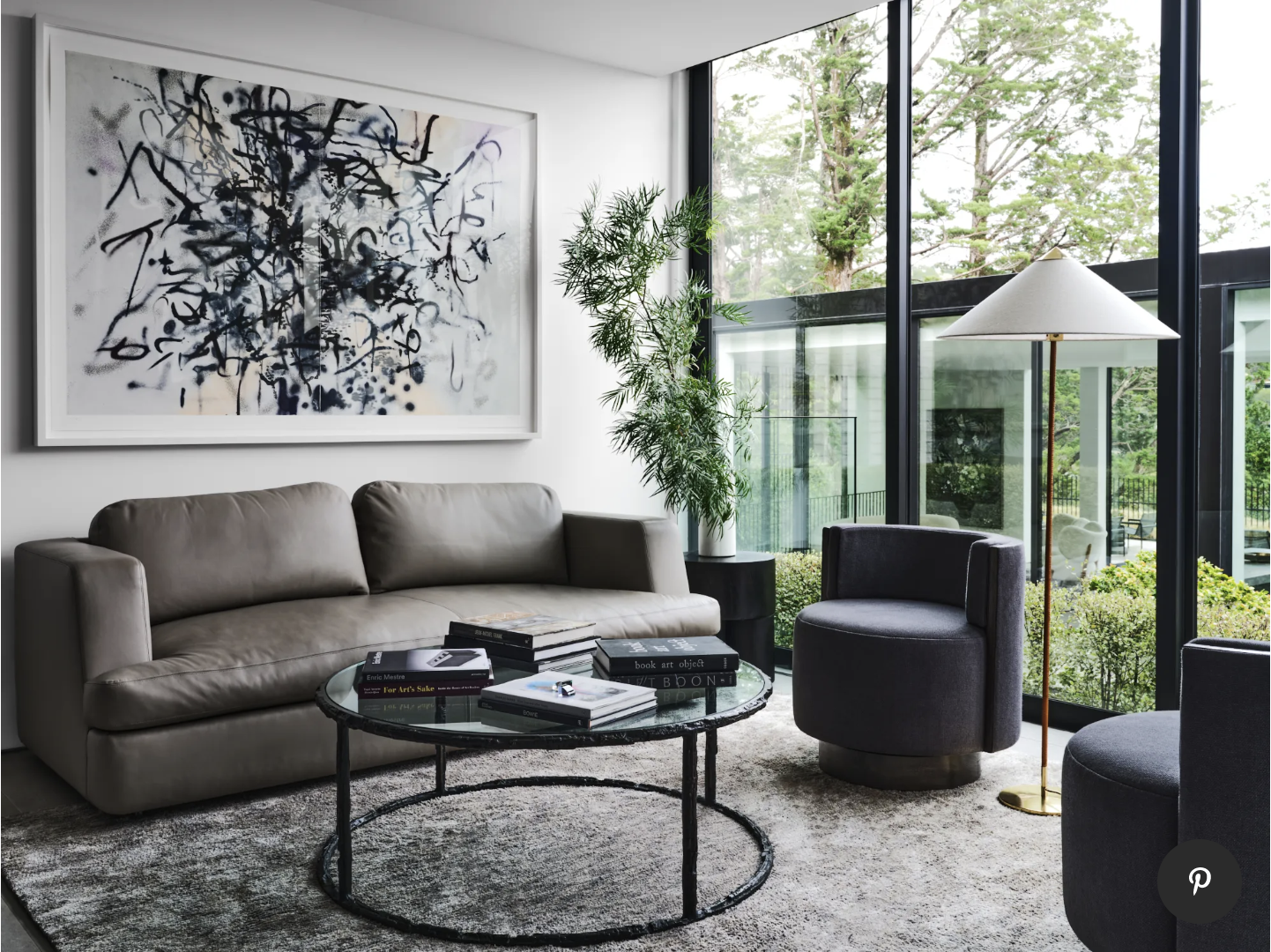Inside Our Art Oasis in Mill Valley
September 13, 2022
Teeming nature meets sleek modernism at our clients’ idyllic residence in the hills of Marin County. The renowned San Francisco architect Stanley Saitowitz designed this unique sanctuary nestled above Mill Valley with a minimal design that emphasizes the stunning view of the Bay. We completed the home by adding a timeless collection of contemporary art that complemented the moody elegance of designer Nicole Hollis’ interior. Together with our savvy clients, we selected each artwork for both its aesthetic merits and deep conceptual meaning. We were able to pair beautiful artworks that reflect many of the client’s passions: from sustainability to Buddhism, world history to the complexity of the natural world.
Install view of Jack Whitten, Loop (In And Out) #4, 2012. Interior Design by Nicole Hollis, photography by Douglas Friedman.
The Entrance | Jack Whitten
Celebrated American artist Jack Whitten created this rhythmic work by laying a piece of string across the surface in loops to create a single calligraphic line, and then covered the paper in pulverized magnetite and acrylic, leaving only the stark white silhouette of the string. Whitten described the string as a “mapping device” used to mark and honor significant locations in his life, from his childhood in segregated Alabama and later as the only Black student in his art class in Manhattan to his later global travels.
Install view of Matthew Day Jackson, Still Life with Tulips, Roses, and Irises in an Unpainted Clay Vase, and Brooch, Ring, and Beetle on a Ledge, 2018. Interior Design by Nicole Hollis, photography by Douglas Friedman.
The Living Room | Matthew Day Jackson
American artist Matthew Day Jackson’s Still Life with Tulips grapples with beauty, artificiality, and mortality by referencing Dutch Baroque floral still lifes. Instead of turning to the traditional medium of oil paint, Day Jackson uses contemporary materials like Formica, fiberglass, cloth, and lead, subtle references to pollution and the toxic chemicals invading our planet. The artist’s message about our environment resonated deeply with our sustainability-minded clients. This work’s prime location at a meeting point between the sleek monochromatic furniture and the vibrant trees outside thoughtfully enhance the artist’s intention.
Install view of Julie Mehretu, Six Bardos: Dream State, 2018. Interior Design by Nicole Hollis, photography by Douglas Friedman.
The Office | Julie Mehretu
On a visit to SFMOMA, our clients were very inspired by Julie Mehretu’s monumental murals in the atrium, they were dedicated to acquiring a work by the acclaimed Ethiopian American artist. Mehretu’s abstracted marks and glyph-like lines are often inspired by world history and politics, which our collectors found very fascinating. Six Bardos: Dream State (2019) belongs to a series of large aquatints inspired by Mehretu’s recent trip to China and refers to the Buddhist bardos: the six transitional stages traversed by the soul between birth and death. This work specifically addresses the second bardo, which describes the phenomenon of lucid dreaming; its complexity is captured spectacularly through Mehretu’s meticulous and layered printmaking process.
Install view of Olafur Eliasson, Mirror my calmness Buddha in me, 2021. Interior Design by Nicole Hollis, photograph by Douglas Friedman.
The Stairwell | Olafur Eliasson
Our clients, environmentalists in their own right, were drawn to Scandinavian Olafur Eliasson because of his career-long interest in nature and sustainability. Anyone who is familiar with Eliasson’s monumental installation “The Weather Project” at the Tate in 2003, understands this artist’s commitment to combating climate change.
Over the last decade, Eliasson has turned to the medium of the glass. Mirror my calmness Buddha in me (2021), a collection of overlapping hand-blown glass circles, reflects his recent fascination with the representation of depth, scientific lenses, and motion in two-dimensional mediums. As such, its new location at the base of the client’s staircase places it at a key junction of movement in the house, and its reflective surface allows the natural beauty of the nearby trees surrounding the home to echo throughout their space.
Install view of Charles Gaines, Numbers and Trees, Tiergarten Series 3: Tree #1-#6, 2018. Interior Design by Nicole Hollis, photography by Douglas Friedman.
The Main Bedroom | Charles Gaines
Our clients resonated with Charles Gaines’ explorations of Tantric Buddhist diagrams and art, which has centrally influenced his signature grid technique. The work above belongs to a series where Gaines photographs trees from meaningful locations – in this case, the Tiergarten in Berlin – and plots them against a grid in order to investigate the way humans respond visually to ordered systems. In his work, Gaines explores facets of human perception and thought. Mirroring the lively trees just outside the adjacent window, this piece ushers the dynamic spirit of nature into the space where our clients rest and reflect.
Trevor Paglen, CLOUD #902 Scale Invariant Feature Transform; Watershed, 2019
dye sublimation print, 48 × 62 1/2 in.
The Lounge | Trevor Paglen
At first glance, CLOUD #902 Scale Invariant Feature Transform; Watershed (2019) presents as a glorious snapshot of picture-perfect clouds, but a closer look reveals perfect circles, lines, and other forms that have been deliberately produced by an algorithm developed to locate anomalies in photographs. According to how this algorithm reads the image, clouds are imperfect and unnatural. Trevor Paglen further alludes to the digital cloud of our age, warning and documenting the invisible infrastructures that surround us. Our clients were particularly compelled by Paglen’s investigation into mass surveillance and personal data collection.







